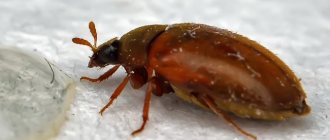The danger of rats getting into the chicken coop
One of the main dangers of rats in a chicken coop is egg theft.
Rodents carry this delicacy constantly, so a person may suffer certain losses. Rats are predators, and quite strong and arrogant. They can injure even larger animals. If a rodent wants fresh meat, it may well attack the chicken. He can easily cope with both young and adult birds, and the rooster will not be able to protect them. Rodents attack every day.
A hungry rat can eat a whole chicken. In other cases, she kills the bird and leaves it after biting it. The rodent destroys chickens very quickly.
Rats are carriers of ticks, fleas, bedbugs, helminths and various diseases:
- plague;
- typhus;
- rabies;
- toxocariasis;
- toxoplasmosis;
- salmonellosis;
- tularemia;
- rickettsiosis;
- leptospirosis;
- listeriosis;
- hemorrhagic fever;
- streptobacillosis.
Many diseases are dangerous not only for poultry, but also for humans. In addition, the presence of a dangerous predator makes chickens anxious, which is bad for their health and productivity.
Rats reproduce quickly, are always hungry and chew a lot. This harms not only the inhabitants of the chicken coop, but also the property. It is not uncommon for a person to discover the presence of rats only weeks or months later until they notice missing eggs or an injured bird.
The danger of rats also lies in their intelligence. They rarely fall into a trap if this has already happened to their relatives. Rat cubs are numerous, and adults teach them to avoid various poisons and traps.
Reasons for rats entering the chicken coop
A rat chicken coop is one of the coziest places to live. Rodents get into a barn for many reasons. The main ones include:
- Availability of premises. Most farmers build a barn leaving a clay floor. This makes it possible to dig and easily enter the building. There are some owners who install the chicken coop high above the ground on stilts, but this is not an obstacle either. Rodents are excellent at climbing trees.
- The chicken room is dry and warm even in winter.
- Lots of food. The bird feeders are filled with food, there are bags filled with grain and feed. Rats also steal eggs.
Biological methods
This method of struggle deserves special attention. It is effective and does not require the use of harmful substances. To do this, get a dog or cat that can catch rats. Not all pets are capable of destroying them, so it is advisable to first ask which ones will be useful for this role. In addition to animals, they use plants that have a strong odor that is unpleasant to rodents. These include: elderberry, mint, chamomile, wild rosemary. They are planted near the chicken coop or twigs are laid out near animal burrows. The good thing about this method is that rodents leave places that are unpleasant for them, and there is no need to bother with corpses.
Damage caused by rats
Rats are a real problem for households. If there is only one individual living in a chicken coop, the problems can be serious, but if there are several, it is difficult to even imagine what they are capable of.
You can expect a lot of trouble from rats:
- They eat and spoil eggs.
- They attack chickens.
- They can infect birds with dangerous diseases.
- Subsequently, the diseases are transmitted to the owners.
Protecting the chicken coop from rodents. Watch this video on YouTube
What kind of rats are human neighbors?
Rats love and often steal chicken eggs.
There are currently more than 70 species of rats. Among them there are those that live only in certain regions, like marsupial rats in Australia.
There are representatives who are pets. Some break records with their size. The rodents are even trained and hired into service, like Gambian hamster rats.
On the territory of Russia and its environs, two types are most often found:
- black rat;
- gray rat Pasyuk.
Destruction of chicken eggs by rodents
Can rats steal eggs from a chicken coop? It turns out they can, and they even have several ways. They act:
- One at a time - they take the egg with two front paws, and move with the help of their hind paws, crawling.
- In twos, one grabs the prey and turns over on its back, while the other drags it by the tail to a secluded place.
It is noted that rats store stolen goods in a certain place and feast on them when the product goes rotten. Now you know how rats steal eggs and ruin their owner. Moreover, these animals move not only on the floor, but also on the walls and ceiling.
Folk remedies
If mechanical and biological means are ineffective, you can try folk remedies:
- Wood ash. It is scattered along the walls. It does not pose any danger to chickens, but the alkali present in it corrodes the paws of rats. It is activated when the rodent begins to lick its dirty paws. The appearance of discomfort forces them to leave the coop.
- A mixture of flour, alabaster, sugar and lime. Rats like its taste, but once inside, it causes organ burns and the rodents die.
- Barrel of water. It should be filled halfway with water, and pieces of lard should be placed on the surface. Place boxes near the barrel, making a kind of ladder out of them so that the rats can get to the treat, the smell of which they can smell well. All that remains is to collect and dispose of the corpses of drowned rodents.
Traps in the chicken coop and the specifics of their use
The easiest way to get rid of rats in a chicken coop is to use a rat trap in a special protective box. The implementation of the design is quite simple:
- Take any box of sufficient size, cardboard or wood;
- Several holes with a diameter of 5-6 cm are cut in its walls right near the bottom;
- A loaded trap with bait is placed at the bottom of the box;
- The box is closed as tightly as possible, and its lid or opening flaps are sealed with tape. This is necessary so that if the chickens turn it over, it does not open;
- The entire structure is installed under one of the perches.
You can check this trap about once a day by removing the tape and opening the box.
On a note
There are special houses on sale today in which you can place both traps and poisons for rats, but due to their relatively high cost they are not in great demand.
It is easier to work with a live trap - it is simply charged and installed anywhere in the chicken coop. What to do with a caught rat is up to each chicken coop owner to decide for himself. Usually they just give it to the cat. The only question here is whether a rat trap is needed if a cat lives on the property...
It is important to remember that there may be several rats in a chicken coop, and traps should be used as long as pests continue to be caught in them periodically. If not a single rat has been caught in two weeks, then we can conclude that there are no rats left in the chicken coop.
They steal eggs, kill 10 chickens: Mutant rats terrorize residents of a microdistrict in Shymkent (VIDEO)
The courtyards in this area are more reminiscent of a golf course with numerous holes. This is a matter, so to speak, of the paws of the new residents. Huge rats feel quite comfortable here and are already entering houses. Now local resident Marya Emelyanova has new neighbors who are threatening to seize her living space.
“I came home and saw them walking around the room. They're not even afraid. And I couldn’t stand it anymore and started calling the sanitary and epidemiological station,” says Marya Emelyanova.
Two years ago, disinfection work was carried out on three streets. Fleeing from toxic chemicals, the rodents migrated, but not far away, and settled with neighbors. Gardens and vegetable gardens were the first to be affected by rats, then the pests began to penetrate houses and sheds. It got to the point that rats started stealing eggs and have already killed several dozen chickens.
“Now we have some even mutated ones: red, white and black. This is the size. Look, they steal eggs, they come from the garden, there is a hole in the summer chicken coop,” said another resident of the area, Irina Shishkina.
Local residents tried to control the pests on their own, but to no avail. The Department of Agriculture and Veterinary Medicine admits that they cannot help all city residents, since the allocated funds - 42 million tenge - are not enough. According to them, almost 50 million tenge is needed to treat waste sites, city rivers and landfills twice a year - in spring and autumn.
“Private houses and legal entities and individuals must do the processing themselves at their own expense. We have 10 such LLPs operating in our city. We can now give you all the telephone numbers; on a contractual basis they must handle all bazaars and large organizations. But sometimes people contact us, we ask these contractors, they do it. Every year money is allocated, so there is a decrease,” said Deputy Head of the Department of Agriculture and Veterinary Medicine Gani Kurmanbai.
Only after people made a fuss and started contacting the media did specialists carry out disinfection, thoroughly treating each hole with chemicals. The next day, the corpses of the rodents were burned. Local residents hope that the pest problem has been completely resolved.
Poison in the chicken coop. In no case?
It should be understood that no matter what the poisoned bait for rats is and no matter what it looks like, there will definitely be chickens who will find it and taste it. Moreover, if the owner of the chicken coop himself is not particularly worried about choosing a product. As a result, there are numerous cases of chicken poisoning with rat poison, most of which resulted in the death of the birds.
The main symptoms of chickens being poisoned by rat poison are refusal to feed, lethargy, ruffled feathers, incoordination, trembling, convulsions, vomiting and bloody droppings. These signs may appear immediately or within 1-5 days, depending on the toxic substance.
In cases of poisoning of a large number of birds, it is advisable to contact a veterinarian to provide qualified assistance; in case of isolated poisonings, you can act independently. Your task is to remove the toxin from the body as quickly as possible. To do this, you need to rinse the stomach with a weak solution of potassium permanganate or activated carbon by oral administration (you can use a syringe) in a volume of up to 2/3 of the crop.
On a note
You should not eat eggs or meat from birds that have been poisoned. There are known cases of poisoning by the eggs of such chickens even 10 days after treatment. Depending on the toxic substance, the process of removing the poison from the bird's body can take more than 2 weeks. A veterinarian can give an accurate prognosis.
But let’s return to the considered method of getting rid of rodents in a chicken coop using poison and note another of its inconveniences - the need to search for and collect dead rats in order to avoid infecting domestic animals with pathogens, the appearance of an unpleasant odor, as well as possible eating by their relatives.
As a result, there are only two acceptable ways to exterminate rats in a chicken coop using poison:
- All chickens are temporarily transferred to another room, and poison, for example, “Rat Death” or “Zookoumarin” is laid out in the old chicken coop. The rats die, then the chicken coop is cleaned and the birds return. To implement this method, additional space and about a week or two of time are required;
- Another option is possible - the same box is placed in the chicken coop as for installing a rat trap. A heavy ceramic plate is placed in the box and beer is poured with the addition of liquid poison for rats (Brommus, Bromed, Brodifan, Indan-Fluid, etc.). The principle here is that rats willingly drink beer and smell it well, but they will only be able to eat poison in the closed box itself, where chickens will not get into. The same can be done if you replace the beer with milk, but in this case the process may take longer because the milk does not smell as strong and rats may not immediately detect it.
As in the case of traps, to prevent chickens from eating rat poison, it can be placed in special plastic houses available for sale today, which are analogues of homemade boxes. Here you should also use only liquid poisonous baits that the rats will not be able to pull out of the house. However, in general, these bait stations are quite expensive, and it can be easier to make your own from a cardboard box, which allows you to effectively get rid of rats without additional cost.
How to get rid of rats using chemicals
Rats are not only harmful and dangerous animals, they are also cunning, which complicates the process of fighting. Control methods such as setting traps are not always effective, since rats easily bypass them. They will always find a loophole into the chicken coop, even if it is equipped with a strip concrete foundation. These pests easily make a dig, after which they enter the room and do their dirty work. However, their nest may be located in a completely different place.
Over the course of many centuries, man has been able to come up with quite reliable ways to protect poultry and get rid of rodents. There are rat-catching cats, but it is very difficult to find such a hunter. Regular house cats don't want to catch mice, let alone rats. Therefore, we have to resort to traditional methods of struggle, as well as the use of chemicals. The most important thing is to start the fight in time so that the rat does not have time to “clean up order” in the chicken coop.
Toxic substances are used only in extreme cases when rodents cannot be controlled. There are ultrasonic repellers, but they do not act so quickly. During this time, rats can cause serious damage to the owner.
On a note! Since there is poultry, toxic substances must be used very carefully, otherwise chickens can be poisoned along with the rats. The poisonous bait is placed so that poultry, including pets, cannot reach it.
How to Protect Chickens and Pets from Poisonous Bait Poisoning
Pets and birds often die after they manage to reach the bait. Therefore, it is very important to protect them from chemicals. Many owners use one suitable method that does not require any time or money. To make the necessary device, you will need materials that can always be found on the farm, plus, you will have to spend very little time. Despite the simplicity of the device, with its help you can protect yourself from troubles.
Stages of manufacturing the device:
- Take a wooden box. It is better if it has a lid that opens so that it is convenient to place the bait.
- Holes 8-10 cm in size are made on all sides of the box so that rats can easily get inside the box.
- Cats, dogs, chickens and children will not fit into such a hole.
- A wooden box with bait can serve as an additional perch for chickens.
Many owners use chemical control agents because they act quickly and effectively. At the same time, care must be taken to ensure that toxic substances cannot be tasted by pets and birds. If you have such confidence, then you can safely begin the operation to exterminate rats.
how to deal with rats. rats in the chicken coop. Watch this video on YouTube
Means "Goliath"
Technical data:
- An effective drug that has the function of mummifying dead animals.
- This drug is used by special services. The substance is sold in volumes from 1 to 10 kg.
- The action of the drug is based on the fact that when the substance enters the stomach of a rodent, it causes a feeling of oxygen starvation, after which the rodents try to get out of their hiding places.
- After 10-12 days, the individuals begin to die, after which they become mummified. This does not alarm the other rats, and they continue to try the bait, after which they die.
- For 1 kg of a toxic substance you will have to pay 2800 rubles, and for 5 kg - all 9000 rubles.
Carbonation
It is the indoor spraying of substances such as chlorine, hydrogen phosphide and carbon monoxide. This processing method is very complex and requires certain knowledge and skills. Therefore, aeration is used only in large poultry farms. The work is usually carried out by disinfection service employees.
You can use the pollination method. Poisonous powder is scattered on the floor, which sticks to the paws and fur of rodents. Rats are very clean, so they lick themselves often. Thus, particles of powder enter the stomach, causing poisoning and death. This method is very effective, but is not suitable for a chicken coop.
Means "Ratid-1"
Description of the substance:
- An effective product is produced in Ukraine and is intended for use in both non-residential and residential premises.
- Available in granule form.
- One package (40 granules) is enough to rid the chicken coop of rats.
- It has the property of mummification, which prevents the decomposition of dead carcasses, eliminates the smell of the chicken coop and makes it impossible for poultry to become infected.
- There is an improved version of the product - “Ratid-2”.
- The product is sold at an affordable price - for 100 g of poison you need to pay 60-70 rubles.
Everyone should know this! Any of the drugs is accompanied by instructions for use. Under no circumstances should it be ignored. A high effect directly depends on compliance with proportions.
Storm
The drug is quite cheap and effective in the fight against rats. Sold in briquettes individually and in sets of 4 pieces. There are also packages with pellets (granular substance) and in containers up to 16 kg.
Mortorat
With the help of this substance you will not have to search for and remove rodent corpses. The drug mummifies them. It differs from other baits in its high efficiency and safety of use.
Appearance: a briquette with a gel-like substance, carefully packed so that there is no contact with the skin (it is better to use gloves when working).
A hole is laid in the hole and then sealed with plaster or cement. There will be no one left to damage the walls.
Rat death
Purpose: large-scale persecution of all types of rodents. The Italian manufacturer guarantees quick freedom from pests.
Sold in two versions. Difference in composition:
- first option: the main component is brodifacoum;
- second type: the basis is bromadiolone.
Ratindane
The bait is effective. Used only in combination with additional ingredients (food). Methods of use: pollination, dilution in liquid or with food.
How to properly use rat repellers in a chicken coop?
Reliable protection of the chicken coop from rats can only be provided by sufficiently powerful repellers. In particular, the effectiveness of the Chiston-2 and Chiston-2 PRO devices, as well as the Bioguard, was tested - according to the results of the experiments, they made it possible to get rid of rats and mice in the premises in approximately 9 cases out of 10.
Such repellers are quite expensive:
- Chiston-2 - approximately 2000 rubles;
- Chiston-2 PRO - about 3,000 rubles;
- Chiston-4 Bioguard - about 4,000 rubles.
There are also many less reliable ultrasonic rat and mouse repellers, and, as a rule, the less the device costs, the lower the likelihood that it will actually help get rid of rodents. However, sometimes even inexpensive models work.
The repeller is installed directly in the chicken coop, plugged into an outlet and works constantly. Practice shows that when using a powerful device, rats leave not only the chicken coop, but also the adjacent buildings.
However, even if a fairly powerful device works constantly, there is a risk that rats running into its area from time to time will cease to be afraid of it. Therefore, after the result is obtained, measures should be taken that in the future simply physically will not allow rats to enter the chicken coop.
On a note
It should be borne in mind that ultrasonic radiation is effective only in the area where the repeller is directed and, like rays of light, cannot overcome physical obstacles - walls, partitions, etc. In addition, it is not recommended for a person to remain in the area of operation of a working device, especially a powerful one, for a long time. In some cases, this can cause headaches or ringing in the ears, so it is recommended to turn off the device before doing any work in the coop.
Ultrasonic repeller
Such devices are sold in any hardware store and are one of the most humane ways to control rodents. The device produces sound waves that are not detected by the human ear, but cause panic and anxiety in rodents, and they urgently leave the room. To select an effective rat repeller, professionals advise paying attention to the following details:
- Power. When choosing a device, take into account the range of action.
- Scene. Ultrasound only travels indoors.
- Safety. The device must operate in the absence of people.
- Change of vibrations. To scare away rats, the oscillation frequency changes automatically so that they do not get used to it.
Repellent
There are three methods of controlling rats in a chicken coop:
Smell
Undermining of the chicken coop's walking area by rats: a strip foundation will not stop them.
Rats have a very sensitive sense of smell, which means they are very sensitive to odors. Like many predators, rodents cannot stand the smell of scorched fur. Rodents associate this scent with danger, and they try to leave the area as quickly as possible.
Folk remedies
The oldest and most effective way to protect chickens from rodents is to scatter stove ash on the floor. It sticks to the feet and fur of rats, and when they begin to lick themselves, it enters the digestive system. Ash is classified as a caustic alkali, therefore, when it gets into the stomach of animals, it causes discomfort and digestive problems. By using ash, you can get double the benefits of repelling rats and ridding chickens of skin parasites.
You can also fight rodents with the help of plants. Burdock and Blackroot officinalis (ratcatcher) help well. These plants have spines that, when in contact with fur, inevitably cling to it. Rats are not able to get rid of stuck thorns, so they will not dig their holes near these plants.
The photo shows the seeds of Blackroot officinalis and the plant itself at the time of flowering. Very often, the Black Root plant is used to control rats in a chicken coop - although the name is similar, it is completely useless for these purposes.
Mint
Rats have a particular dislike for mint. This plant is akin to a weed, and it can be found in almost any area, growing in a chaotic manner among noble plantings. However, its mere presence in the garden is not enough. In order for mint to be useful, it is picked and dried, then tied into small bouquets and hung in the corners of the chicken coop.
Chickens and other birds are neutral to the smell of mint, but rats are unlikely to decide to stay in such a place for a long time. Or they may not want to enter it at all.
Sagebrush
Wormwood has a similar effect on the nervous system of rats. It grows much more actively than mint, and quite often gardeners pull it out as an unnecessary weed, simply not realizing its beneficial properties. In order to use wormwood against rats, it must be collected during the flowering period, dried, and hung in the corners of the room for the winter. Dried wormwood can also be placed under stacks or spread between sheaves.
Blackroot
Dried black root, which is usually called mouse spirit or cat soap, is good against rats. It is also laid out in the chicken coop either in the hay or on the floor.
Autumn colchicum
This plant is poisonous, so it is not sold in pharmacies. You can assemble it yourself, but wear protective gloves. As a poison, you can take 1/5 kg of seed material or add 10 g of grass to food.
In the fight against rats, all the methods described above are effective; each farmer chooses the most suitable ones for himself. The main thing is to remove these rodents completely so that poultry and animals do not suffer in the future.
Uses of gypsum and lime
To prepare baits, take gypsum or lime and mix it in equal parts with corn flour. Add milk or kefir to the resulting mixture and roll into small balls. They are placed in places where animals gather or in their burrows. After the balls disappear, you need to add new bait.
Ash – wood and stove
Ash has the property of killing rats, so you should temporarily move the poultry to another room, and scatter as much ash as possible in the chicken coop! It sticks to the paws of rodents, then enters their intestines and gradually eats away at it. At the same time, the rats experience severe pain. The death of animals occurs a few days after this substance enters their stomach.
Bird cherry and elderberry
To protect not only the chicken coop, but also the garden, you can plant bird cherry and elderberry bushes. However, you need to be careful with the latter, as elderberry is poisonous. You need to plant it so that small children cannot reach the bush. If it is not possible to either plant a bush or fence it, then you can put dried elderberry branches in the chicken coop.
Ultrasonic devices
You can purchase special repellers on the market that emit sound signals of a certain frequency. This sound is only audible to rodents and causes them to panic. Therefore, rats try to get away from dangerous territory.
It is important to provide escape routes for pests in the first days of ultrasound operation.
In theory, everything is fine, but in practice, such devices are strictly divided into 2 types.
- Low-power, battery-powered, with a short range. Due to this, it is useless to use such ultrasonic repellers in a large chicken coop.
- Professional devices powered from the network. There are some powerful ones that are only suitable for warehouses (the instructions say that they should be turned on in the absence of people).
The main thing in this disposal method is a balanced approach to choosing a specific model.
Among the well-known and advertised brands in Russia, it is worth mentioning the Tornado ultrasonic repeller. About 10 different versions of these devices are produced: from those that are inserted into an outlet like a fumigator to more stationary ones that operate from 220 volts.
“Torando 800” has a range of 800 meters and can be used in small chicken coops. Reviews indicate good effectiveness against rats. The price of the device (winter 2015) is about 3,000 rubles.
In second place in popularity are the brands Typhoon and Grad. webferma.com considers the Grad A-1000 PRO+ to be the most advanced model. The manufacturer claims that the device is equally effective in the fight against mice, moles, rats and insects (ticks, moths, mosquitoes, fleas). It is possible to switch on by timer, and the “unique radiation scheme” prevents pests from becoming addicted.
Introducing other birds and animals
It is effective to have geese or turkeys in the chicken coop, which are able to protect themselves from rats. Geese are distinguished by their sensitive sleep and reaction to the slightest rustle. Their cackling repels rats. Turkey produces a similar effect.
You can also get an outdoor cat or a hunting dog. Such animals will catch rodents, but at the same time create a risk for the chickens themselves. A well-trained dog will not harm poultry.
Another animal that can scare away and even catch rats is the hedgehog. This nocturnal inhabitant is a good substitute for a cat, which itself can harm chickens or feast on their eggs.
Mousetraps and traps
Such large structures can easily slam a rat or cause serious injury to it. When placing mousetraps, you must remember that curious birds can get into them.
Spring structures are considered the most effective. You need to pay attention to the material used - the rat trap must be durable.
A rat trap-squeeze helps a lot. Such traps should be placed in boxes, leaving a small entrance hole. It is good to use fried meat as bait. Instead, you can take a piece of bread and dip it in vegetable oil. This method cannot be used if there are chickens in the coop. Due to their small size, they can become trapped themselves.
Another effective option is an electric trap. It works due to the electric charge that the rat receives by closing the contacts with its paws. This charge is enough to stop the pest's heart.
This method of getting rid of rodents is ineffective, so it should be used in addition to other measures. Rats are very smart and rarely fall into such traps.
Glue traps
This method is usually used for mice, since rats are able to escape from the trap. For larger rodents you just need to use more material.
Special glue can be purchased at a hardware store. The tube should be kept in hot water for several minutes, and then its contents should be applied to the board. Rodents can be caught without additional bait, but to be effective, it is better to use it.
The glue does not dry for many days. The fur is tightly glued to it, so the animal cannot free itself. The rat may escape, but will leave some fur in the trap, sometimes resulting in serious wounds. This will force the rodent to look for a safer place to live.
Birds can also fall into such traps, so they should be placed under drawers or boxes where chickens cannot get into, but rodents can. Several entrances and exits must be made in the prepared box, otherwise the rat will sense danger.
Difficulties in fighting rats
People have been fighting them for a long time. They get rid of rodents in different ways. That is why rats have developed many methods of defense and the ability to survive in any conditions. Do not underestimate the mental abilities of animals, which also complicates the fight against them.
Rats sense danger and behave very carefully. They deftly bypass prepared traps and warn other individuals about them. Their intelligence is also evidenced by the fact that rats steal eggs from the chicken coop (photo posted in the article). Experts say that they do not abandon their elderly relatives and take care of them, and teach the young to hunt and avoid danger. Therefore, when choosing methods of rodent control, all these nuances should be taken into account. A person will have to use cunning and ingenuity to defeat the dangerous pest.
Mechanical methods of struggle
Can rats steal eggs? Yes, they can and do come up with clever ways. The owner of the chicken coop can suffer significant damage, so it is imperative to fight them. For this purpose, mechanical traps are used, inside which bait is placed.
They are installed in places inaccessible to hens and chicks so that they are not caught instead of rodents. And cunning rats can bypass them. Glue traps are often used, which are ineffective for strong adults that can tear their paws off the smeared surface. Another drawback: the rodent remains alive and must be destroyed or released by someone.
How to prevent rodents from appearing in a chicken coop
If chemical treatment or spreading of poison in the chicken coop is planned, then it is better to move the birds to another room before starting to poison the pests. If this is not possible, then the bait needs to be covered with a small box, cutting a hole in it with a diameter of 6 cm. The animal will get to it, but the birds will not be able to.
When using poison, it is also necessary to take into account the fact that a dead carcass can attract a curious chicken, she will want to try it.
Domestic cats and dogs will not refuse such food, which is why they may also die. Therefore, you need to regularly inspect the premises and yard, collect animal corpses and burn them so that your pets do not have time to feast on them.
When scattering bait in the chicken coop, you need to analyze whether rodents can spread the poison throughout the chicken coop, and who else would want to try such food.
You need to be careful with the traps you set. Even an adult can get caught in them. Well, if there is a hen with babies in the chicken coop, then the use of traps is simply unacceptable.
Suitable preventive measures include purchasing a cat or dog.
Not all cats are able to catch a rat. Sphynxes and Siberian cats cope well with rodents. However, the sphinx will not be able to help with household protection in winter.
Among dogs, Jagdterriers, dachshunds, fox terriers, and representatives of the Jack Russell breed are famous for their hunting abilities. However, not everyone can start exterminating rats on their own; some of them will need to be taught to hunt.
Other birds and animals will also help in the fight against rodents. Turkeys and geese do not sleep as soundly as chickens; the slightest rustle can wake them up. They will begin to create their own alarm cry. Such cackling can scare off unwanted neighbors.
It would be good if hedgehogs settled on the farm territory. They are excellent rodent hunters. Hedgehogs act as reliable guards for birds against rats and mice at night.
Humane control methods that will not harm birds include burdock and black root plants. They are planted next to the hole. The spines of these plants cling to the fur of pests. Animals cannot get rid of them on their own, so they will prefer not to pass near them. The smell of elderberry, wild rosemary, mint, and onion repels uninvited guests.
One of the important preventive measures is the correct construction of the shed. The room must be built of brick, the floor must be filled with concrete, it must be ensured that the doors fit tightly, and the building does not have a single crack through which an unexpected guest could enter. Around the chicken coop at a depth of half a meter you can dig in sheet iron or a mesh with small cells.
To prevent rats from choosing the chicken coop, it is necessary to control the availability of food for the birds. It should not be in excess. Grain stocks should be stored in a separate room in durable containers with a tight-fitting lid.
The fight must begin as soon as it becomes clear that there are rats in the chicken coop. After all, getting rid of mice is much easier than getting rid of them. Rats can reproduce quickly. Their family diligently protects their older generation, because they learn from them. These animals are quite smart. The whole flock does not immediately attack the bait. They select an individual to try the food and observe the taster for several days. If he dies, the others will not touch the bait.
Unexpected guests will continue to dig labyrinths, destroy grain reserves, steal chicken eggs and tear apart chickens. The owner risks his health by consuming meat and eggs of birds that live next to pests.
How to protect birds and animals when using poisons
When destroying rodents with pesticides, it is necessary to remember that not only rats can suffer. The poison is also of interest to chickens. They will also want to try it, so you need to place the poison in places inaccessible to birds and pets. A poisoned rat is also dangerous. A cat can eat it, after which it will most likely die too. To ensure the safety of chickens and animals, you must follow a few simple rules:
- If using poison, move the chickens to another house or separate room. Place a poisonous substance in the barn with rodents. After the death of the rats, thoroughly clean the room. Check for dead rodents under the hay. Remove the old flooring with any remaining poison and cover it with a clean one, and only then place the birds back into the coop.
- If you don't have a spare coop, you can use another chicken-safe method. Place the poison in a wooden box, preferably one with a hinged lid. Make through holes in it so that the rodent can get inside. There should be two holes, because if there is no way out of the box, the rat will not climb into a closed room. Having caught the delicious aroma, the animal will run into the box. Neither chickens nor other animals will be able to get inside and will remain safe. To prevent the box from falling or being overturned by birds, place something heavy on it.
- Provide chickens with a metal mesh enclosure. Install protection not only on the sides, but also on the top.
Poultry house reconstruction
The main purpose of a chicken coop is to keep the birds comfortable and to protect the premises from pests. This should be taken care of at the stage of its construction or during operation. Remembering how rats steal eggs, showing their agility, you need to create unfavorable conditions for them. Since there is plenty of food in the chicken coop, you need to be concerned about its tightness. For this:
- When building a chicken coop, place a concrete foundation under it.
- Make the walls impenetrable. Rats are able to penetrate through a very small hole, so it is advisable to cover the side surface of the building with metal sheet to a height of at least a meter.
- Install metal doors so that there are no gaps.
- The windows should be glazed and the floor concreted; the rats will gnaw through all other materials and insulation.
- Keep the room clean. Systematically remove droppings, monitor the hygiene of food trays, and collect eggs in a timely manner.
Having eliminated the access of rodents from the outside, you can start exterminating them inside: yourself or invite specialists.
Chemical method
To the question of whether rats steal chicken eggs, there is only an affirmative answer. Therefore, it is imperative to get rid of rodents in the chicken coop. Insecticides, the range of which is very large, are suitable for this. But it is important to remember that pesticides are not safe for birds. Therefore, when using them, the chicken coop is cleared of its inhabitants for a while, moving them to another room. Gaseous preparations are considered the most effective means, but to use them you need to invite a specialist.
When treating with chemicals, you should always remember that rats can develop immunity to them. It is best to use new drugs that have just appeared on the market. They do not have an immediate effect, so it is necessary to remove the corpses of pests in a timely manner.
Preventive measures against the appearance of rats
Try to carefully inspect the entire room
A far-sighted farmer must anticipate the danger of rodents and take preventive measures even at the stage of building a chicken coop. This will be of great help in protecting the chickens when rats are invading their home.
Chicken coop walls and floor
During construction, it is recommended to adhere to the following recommendations:
- The floor of the room must have a concrete base.
- To build walls (or at least parts of them half a meter from the ground), it is best to use brick - it is much more difficult for pests to get through such a barrier than through wood.
- The bottom of the walls must be sheathed with sheet iron and preferably so that each sheet goes deep into the ground.
- It is better to cover the foundation of the chicken coop with fine mesh galvanized mesh or lay it under a layer of plaster if the walls will be treated with plaster.
- There should be no voids in the floor and walls; any cracks and holes must be carefully sealed with glass wool and cement with the addition of broken glass.
- When installing doors, you need to make sure that they close as tightly as possible.
.
Rat poison
Even if the rats have not yet visited the chicken coop, there is a reason to purchase and place rat poison in advance in places inaccessible to chickens and other domestic animals.
Even if the rats have not yet visited the chicken coop, there is a reason to purchase and add rat poison in advance
Such a means of defense will help destroy at least some of the rats trying to get into the house and scare away their relatives.
Glass and crushed stone
A mixture of crushed stone and glass is a common and effective method. This mixture is used at the construction stage when laying the foundation.
Crushed stone is mixed with a large amount of broken glass and poured into the foundation. After this, it is filled with concrete, into the solution of which broken glass is also added. A rat can overcome ordinary concrete, but it will be difficult for it to fight glass.
A mixture of crushed stone and glass is also laid out on the ground around the perimeter of the entire chicken coop. A solid layer at least 15-20 cm wide will become a serious obstacle to pests.
The mixture can also be placed in the chicken coop itself - it is safe for the rough skin of chicken feet.
How to solve a problem
The first step is to identify the egg eater. To do this, the head, feathers and beak of each chicken are examined. The culprit is identified by traces of dried yolk. If the procedure does not produce results, a dummy egg filled with food coloring is used.
A bird with a colored beak moves to an isolated place. She is returned to the chicken coop only if she gets rid of the bad habit.
After determining the exact cause of the pecking, the necessary measures are taken. There are several options to solve the problem.
If changing the diet and improving living conditions do not have the desired effect, you can use traditional methods. Eggs are replaced with white dummies made of wood, plastic, or salt dough. This method quickly gets rid of a bad habit.
Replacing the contents of the egg helps a lot. The white and yolk are extracted with a syringe. The shell is filled with mustard or a mixture of hot spices. Their taste discourages them from pecking at the eggs.
The article describes simple and effective ways to solve the problem. If they do not bring results, and the bird’s behavior cannot be corrected, it is sent for meat.
Source











